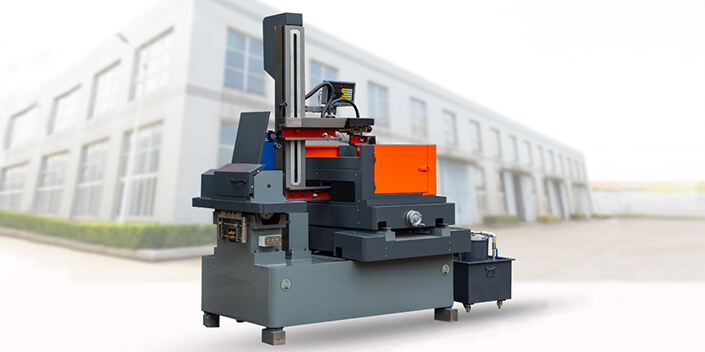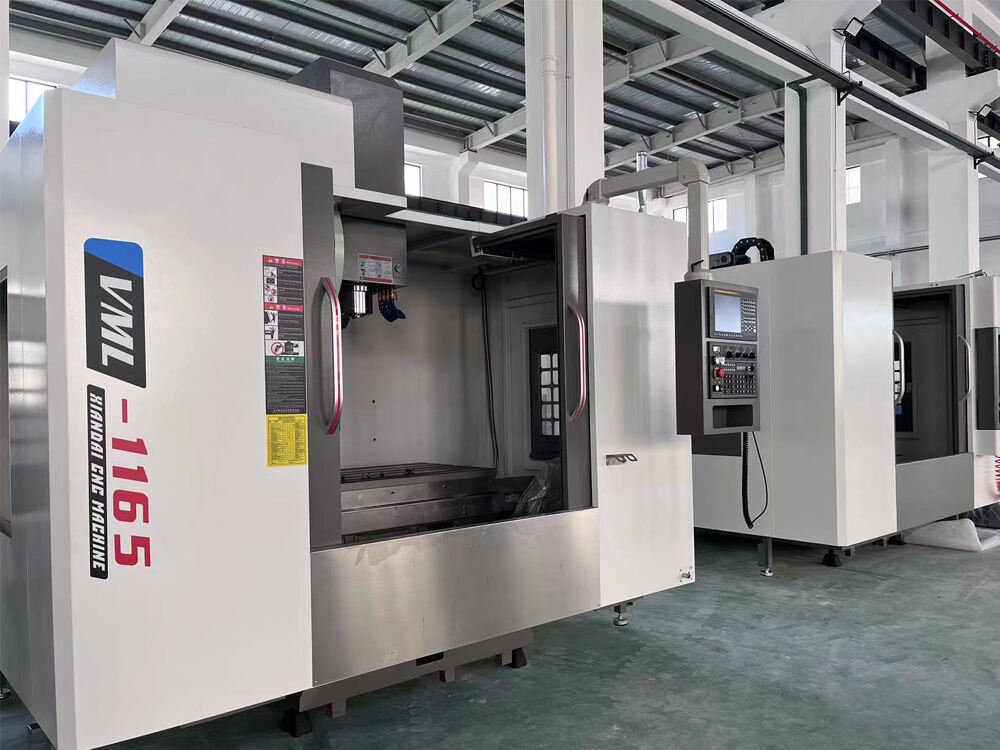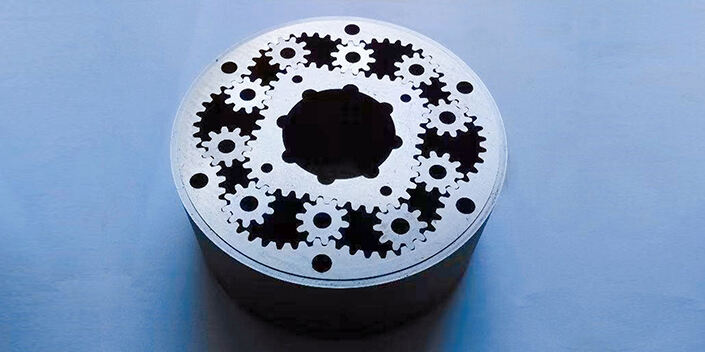Prinsipyo ng Pagpapatakbo ng EDM Spark Erosion Machines
Ano ang Electrical Discharge Machining (EDM)?
Ang EDM ay kumakatawan sa Electrical Discharge Machining, na gumagana bilang alternatibong paraan upang alisin ang materyal mula sa mga bahagi na nagpapakilos ng kuryente. Sa halip na gumamit ng karaniwang mga kasangkapang pamputol, umaasa ang mga makina ng EDM sa mga elektrodo na gawa mula sa mga materyales tulad ng tanso, brass, o grapiya. Ang mga elektrodong ito ay lumilikha ng maliit na mga spark sa napakataas na dalas na talagang nakakakain sa workpiece nang hindi ito hinihipo nang pisikal. Ang nagpapahalaga sa EDM ay ang kakayahan nitong makaputol sa pamamagitan ng talagang matitigas na bagay tulad ng pinatigas na bakal at tungsten carbide, na mga materyales na karaniwang nagdudulot ng hirap sa mga karaniwang teknik ng machining. Ang mga shop na nagtatrabaho gamit ang mga hamon na materyales na ito ay kadalasang umaasa sa EDM kung ang mga tradisyonal na pamamaraan ay hindi magagawa ang trabaho nang tama.
Ang Spark Erosion Process: Paano Nagtatanggal ng Materyales ang EDM nang May Tumpakness
Ang mga EDM spark erosion machine ay gumagana sa pamamagitan ng paglikha ng voltage difference sa pagitan ng electrode at ng workpiece na nasa loob ng espesyal na dielectric fluid. Habang lumiliit ang distansya sa pagitan nila, mga 0.01 hanggang 0.05 millimeters, mayroong matinding electrical discharge. Ito ay naglilikha ng sobrang mainit na spot, minsan ay umaabot sa mahigit 10,000 degrees Celsius, na nagtatapon ng maliit na bahagi ng materyales kung saan ito umaabot. Nakakainteres ang paraan kung paano gumagana ang dielectric fluid pagkatapos nito. Ito ay mabilis na nagpapababa ng temperatura at nag-aalis ng lahat ng maliit na partikulo na natanggal, upang ang buong bahagi ay hindi mawarpage dahil sa init. Ang ilang modernong makina ay maaaring magpalabas ng hanggang sa kalahating milyong sparks sa bawat segundo! Ang bilis na ito ay nagpapahintulot sa mga manufacturer na tanggalin ang materyales sa bilis na 10 hanggang 20 cubic millimeters bawat minuto kapag gumagawa ng bakal, habang pinapanatili ang napakataas na katiyakan na nasa loob ng plus o minus 5 micrometers.
Hindi Nakakadikit na Pagmamanupaktura: Bakit Nakakapigil ang EDM sa Mekanikal na Stress at Pagbaluktot
Gumagana nang magkaiba ang EDM dahil walang tunay na paghipo sa pagitan ng kagamitan at ng pinoproseso. Ito ay nangangahulugan na ang mga abala na pag-ugoy at pwersa mula sa gilid na nagbabaluktot sa manipis na pader o nakakaapekto sa mga metal na may paggamot sa init ay hindi nangyayari. Para sa mga bagay tulad ng mga bahagi ng eroplano, lalo na ang mga blade ng turbine, ito ay napakahalaga. Noong nakaraang taon, ilang pag-aaral ay nakakita na ang paggamit ng EDM sa halip na regular na milling ay binawasan ang pagbabago ng hugis pagkatapos ng pagmamanupaktura ng halos 9 sa 10 kaso. Ang industriya ng kagamitang medikal ay gumagamit din nito kapag gumagawa ng mga komplikadong implantasyon sa gulugod na gawa sa titanoy. Maaari nilang likhain ang mga detalyadong hugis nang hindi nababahala sa paglabag sa sukat ng higit sa 3 microns sa alinmang direksyon, na talagang kahanga-hanga kung isinasaalang-alang kung gaano kakaunting sukat ang kailangan ng mga bahaging ito.
Katiyakan sa EDM na May Sukat na Micron-Level
Ang mga EDM spark erosion machine ay nakakamit ng micron-scale na katiyakan sa pamamagitan ng controlled electrical discharges, kung saan ang mga nangungunang sistema ay mayroon nang maayos na tolerances sa loob ng ±2µm (±0.002mm). Ang katiyakang ito ay nagmula sa tatlong synergistic factors: non-contact material removal, real-time electrode positioning control, at optimized dielectric fluid dynamics.
Pagkamit ng Tolerances na Kasingliit ng ±2µm
Ang modernong wire EDM system ay pinagsasama ang 50nm-resolution linear scales at adaptive spark gap monitoring upang i-machine ang mga bahagi tulad ng fuel injector nozzles at medical implant guides. Hindi tulad ng mga conventional cutting tools na lumilihis sa ilalim ng presyon, ang EDM's non-mechanical process ay nagpapanatili ng ±2µm positional accuracy kahit sa 60HRC tool steels.
Mga Salik na Nakakaapekto sa Katiyakan at Repetibilidad sa EDM
- Electrode Wear Compensation - Ang mga awtomatikong sistema ay nag-aayos para sa 0.2-0.5% copper electrode erosion bawat operasyon
- Katatagan sa Init - Ang mga frame ng makina ay nagpapanatili ng ±0.1°C sa pamamagitan ng active cooling upang maiwasan ang thermal growth
- Dielectric Control - Ang maramihang filtration ay nagpapanatili ng resistivity ng fluid sa itaas ng 5–10 MΩ·cm para sa pare-parehong spark energy
Kaso ng Pag-aaral: ±3µm Tolerance sa Pagmamanupaktura ng Bahagi ng Aerospace
Isang proyekto ng aerospace turbine noong 2023 ay gumamit ng sinker EDM upang lumikha ng mga cooling channel sa nickel superalloys na may ±3µm profile accuracy. Ang proseso ay nakamit ang 0.08mm na sukat ng sulok habang pinapanatili ang 0.3mm na manipis na bahagi sa bilis na 48% na mas mabilis kaysa sa mga alternatibo sa laser cutting.
Papel ng Dielectric Fluid at Electrode Control sa Pagpapanatili ng Katiyakan
Ang high-pressure dielectric flushing (12–15 bar) ay nagtatanggal ng debris sa loob ng 0.3ms ng bawat spark, pinipigilan ang pangalawang discharges na nagdaragdag ng kerf width ng 5–8µm. Nang sabay-sabay, ang 0.05µm-resolution linear motors ay nag-aayos ng wire tension (±0.01N) at feed rates (0.05–6mm/min) upang kompensahin ang thermal expansion sa loob ng 80+ oras na machining cycles.
Mahusay na Surface Finish Nang Wala ng Secondary Operations
EDM Surface Finish Capabilities: Mula sa Ra 0.1µm hanggang sa mga Resulta na Katulad ng Salamin
Ang mga makina na gumagamit ng spark erosion sa EDM ay maaaring lumikha ng surface finishes mula Ra 0.1 microns hanggang sa mga surface na kayang magreflect ng liwanag tulad ng salamin. Ang nagtatangi nito sa mga regular na pamamaraan ng machining ay ang tradisyonal na mga pamamaraan ay iniwanan ng mga nakikilalang marka ng tool, samantalang ang EDM ay gumagana nang naiiba sa pamamagitan ng paglikha ng mga maliit at magkakatulad na craters sa pamamagitan ng init. Ayon sa isang ulat na inilathala noong nakaraang taon ng Advanced Manufacturing, halos 40 porsiyento ng mga kumpanya na gumagawa ng mga bahagi para sa eroplano ay tumigil na sa anumang karagdagang pagtatapos dahil ang EDM ay nagbibigay sa kanila ng eksaktong kailangan nila para sa mahahalagang bahagi na dapat sumunod sa mahigpit na mga kinakailangan sa Ra finish na nasa ilalim ng 3 microns. Dahil sa mga kakayahan nito, maraming mga manufacturer ang nakikita ang EDM na partikular na kapaki-pakinabang kapag ginagawa ang mga bagay tulad ng mga surgical implants o mga molds para sa mga lens kung saan ang pinakamaliit na surface irregularities ay maaaring makaapekto sa kung gaano kahusay ang pagganap ng final product.
Pagtanggal sa Pangangailangan ng Post-Processing at Polishing
Sa pamamagitan ng pagkamit ng pangwakas na kalidad ng ibabaw habang nasa paunang yugto ng machining, binabawasan ng EDM ang mga hakbang sa workflow at basura ng materyales. Halimbawa:
- Walang manu-manong pagpo-polish kinakailangan para sa 95% ng pinatigas na tool steel molds (base sa mga benchmark ng industriya)
-
Zero na panganib ng sobrang pagpo-polish delikadong mga tampok tulad ng manipis na pader o matulis na mga gilid
Mahalaga ang ganitong pagtaas ng kahusayan para sa mga materyales na may mataas na halaga tulad ng tungsten carbide, kung saan ang mga pangalawang operasyon ay nagdaragdag ng gastos ng hanggang $240 bawat parte (Journal of Manufacturing Systems, 2022).
Pagbalanse ng Bilis ng Pagputol at Kalidad ng Ibabaw sa Produksyon
Ino-optimize ng mga operator ang mga parameter ng EDM upang matugunan ang mga kinakailangan ng proyekto:
| Parameter | Modong mabilis | Precision Mode |
|---|---|---|
| Katapusan ng ibabaw | Ra 1.2–2.5µm | Ra 0.1–0.8µm |
| Material Removal | 450 mm³/hr | 120 mm³/hr |
| Karaniwang Gamit | Paggawa ng prototype | Final surfaces |
Ang kakayahang ito ay nagpapahintulot sa mga manufacturer na bigyan-priyoridad ang bilis sa panahon ng roughing stage habang inireserba ang mas mabagal at mas detalyadong pagputok para sa kritikal na mga surface—isang estratehiya na nagpapakita ng pagbawas sa kabuuang oras ng production cycle ng 18–22%sa mga production environment.
Burr-Free at Stress-Free Machining: Mga Pangunahing Bentahe ng EDM
Ang EDM spark erosion machine ay nagkakamit ng tumpak na pagpoproseso ng metal nang walang mechanical stress sa pamamagitan ng kontroladong electrical discharge. Ang non-contact na pamamaraan na ito ay nagpipigil ng deformation habang pinapanatili ang integridad ng bahagi, kaya ito ay mahalaga para sa mga mission-critical na bahagi.
Paano Binabawasan o Nililimot ng EDM ang Mga Kinakailangan sa Post-Processing
Ang non-contact na proseso ng pagtanggal ng materyales ng EDM ay nagpipigil ng pagbuo ng burr sa pamamagitan ng pagpapasingaw sa halip na pagputol ng metal. Ang dielectric fluid ay nag-aalis ng mga naapektuhang partikulo, lumilikha ng mga surface finish na maayos na hanggang Ra 0.4µm—na karaniwang tumutugon sa huling mga espesipikasyon nang walang kinakailangang ipolish. Ito ay nag-elimina sa mga yugto ng paggiling at pag-alis ng burr na nagdaragdag ng 15–30% na oras sa mga konbensional na machining workflow.
Walang Burrs, Walang Warping, Walang Tool Wear – Ang EDM Advantage
Nang walang tool-workpiece contact, ang EDM ay nakakaiwas sa:
- Pagkasira ng tool : Ang mga electrode ay tumatagal ng 10x higit sa mga milling cutter sa matitigas na materyales
- Pagkabagot dahil sa init : Ang mga discharge energy na nasa ilalim ng 0.1J ay nagpipigil ng heat-affected zones
- Mekanikal na Stress : Ang mga delikadong feature na pababa sa 0.2mm na kapal ay nananatiling buo
Ito ang nagtatag ng EDM bilang ideal para sa aerospace fuel nozzles at medical implants kung saan ang micro-defects ay hindi tinatanggap.
Matagalang Kahusayan Sa Kabila ng Mas Mabagal na Pag-alis ng Materyales
Ang EDM ay nag-aalis ng materyales nang mas mabagal kaysa sa milling (2–8mm³/min laban sa 30–100mm³/min), ngunit nakakamit nito ang mas mahusay na kabuuang kahusayan sa pamamagitan ng:
| Factor | EDM Advantage |
|---|---|
| Pagpapalit ng Tool | 90% na pagbaba |
| Tasa ng Basura | 3x mas mababa para sa mga hugis na kumplikado |
| Pagsesta ng Surface | 50–70% na oras na naka-save |
Ang mga benepisyong ito ay nakokompensa ang mas mabagal na bilis ng pagputol, lalo na sa mga aplikasyon na kasangkot ang hardened tool steels at tungsten carbide.
EDM para sa Matigas na Materyales at Komplikadong Geometry
Paggawa sa Hardened Steels, Tungsten, at Carbide nang Madali
Ang mga spark erosion machine na ginagamit sa EDM ay talagang epektibo sa pagtratrabaho sa mga super hard materials na nasa itaas ng HRC70. Kayang-kaya nilang gamitin ang hardened tool steel, tungsten alloys, at mga matigas na carbide materials na hindi kayang i-cut ng mga regular na tool. Ang mga tradisyonal na pamamaraan sa machining ay madalas nagkakaroon ng problema kapag kinakaya ang ganitong antas ng hardness dahil mabilis ngumugulo ang mga tool o nababawasan ang integridad ng workpiece habang nasa proseso. Ang nagpapahiwalay sa EDM ay ang paraan ng pagtratrabaho nito gamit ang init imbis na pisikal na presyon. Ang machine ay literal na tinutunaw ang materyales nang hindi direktang nakakadikit. Dahil walang contact ang proseso, ang mga manufacturer ay makakapag-cut ng mga detalyadong hugis sa mga bagay tulad ng aerospace turbine blades at carbide inserts nang hindi nababago ang structural properties ng mismong materyales. Ito ay naging lalong importante sa mga industriya kung saan ang precision ay higit na kritikal.
Paglikha ng Mga Komplikadong Cavities at Contours na Hindi Maabot ng Konbensiyonal na Paraan
Ang teknolohiya ay nakakamit ng mga geometry na imposible sa pamamagitan ng milling o turning, tulad ng 50:1 depth-to-width ratios sa mga cooling channel o ±3㎛-tight radii sa microfluidic devices. Isang pag-aaral noong 2023 na isinagawa ng Advanced Manufacturing Institute ay nakatuklas na ang EDM ay binawasan ang scrap rates ng 18% habang gumagawa ng fuel injector nozzles na may 0.05mm cross-holes. Ang mga programmable electrode paths nito ay nagpapahintulot sa:
- Three-dimensional spiral cavities para sa plastic injection molds
- Undercuts at sharp internal corners sa medical implants
- Micro-features na nasa ilalim ng 50㎛ sa mga bahagi ng relos
Lumalaking Paggamit sa Industriya ng Mold at Die Manufacturing
Higit sa dalawang ikatlo ng mga taong nagtatrabaho sa precision mold making ay nagsimula nang gumamit ng EDM technology tuwing kinakasangkot ang mga kumplikadong core pins at ejector systems. Ang industriya ng sasakyan ay talagang nakikinabang din mula rito dahil ang EDM ay kayang gumana sa hardened die casting molds gamit ang 5 axis machining. Tinatanggalan nito ang lahat ng oras na kinakailangan sa kamay na pagpo-polish dati nang umaabot ng ilang linggo. Dahil naman sa kagustuhan ng mga manufacturer ng mga bahagi na mas maliit at mas magaan na gawa sa mga bagong materyales, ang EDM ay naging mas mahalaga. Nakikita natin itong ginagamit sa paggawa ng mga espesyal na cooling channels sa loob ng die casting dies pati na ang mga kumplikadong surface patterns na kailangan para sa optical molds sa iba't ibang sektor.
Mga madalas itanong
-
Anong mga materyales ang pinakamainam para sa EDM machining?
Mataas ang epekto ng EDM sa matigas na mga materyales tulad ng hardened steel, tungsten carbide, at anumang electrically conductive na materyales. -
Paano nagkakamit ng mataas na precision ang EDM?
Nakakamit ang EDM ng micron-level na katiyakan sa pamamagitan ng non-contact na pagtanggal ng materyales, real-time na kontrol sa posisyon ng electrode, at na-optimize na dielectric fluid dynamics. -
Tinatapos ba ng EDM ang mga kinakailangan sa post-processing?
Oo, madalas makamit ng EDM ang huling kalidad ng surface habang nasa proseso ng machining, na binabawasan o ganap na nililimot ang pangangailangan ng karagdagang finishing, paggiling, o pagpo-polish. -
Ano ang mga bentahe ng EDM kumpara sa tradisyonal na machining?
Nagbibigay ang EDM ng tumpak na pagputol nang walang mekanikal na stress, nililimot ang mga burrs, at nangangailangan ng mas kaunting post-processing operations, na nagiging ideal para sa mga kumplikadong at mataas ang halagang bahagi. -
Mas mabagal ba ang EDM kumpara sa tradisyonal na pamamaraan?
Bagama't maaaring mas mabagal ang EDM sa pagtanggal ng materyales, ang kanyang mas matagal na kahusayan sa lifespan ng tool, binabawasan ang scrap rates, at pagtatapos ng surface ay karaniwang nagpapahusay sa kanyang kalamangan para sa mga aplikasyon na nangangailangan ng mataas na katiyakan.
Talaan ng mga Nilalaman
- Prinsipyo ng Pagpapatakbo ng EDM Spark Erosion Machines
- Katiyakan sa EDM na May Sukat na Micron-Level
- Mahusay na Surface Finish Nang Wala ng Secondary Operations
- Burr-Free at Stress-Free Machining: Mga Pangunahing Bentahe ng EDM
- EDM para sa Matigas na Materyales at Komplikadong Geometry
- Paggawa sa Hardened Steels, Tungsten, at Carbide nang Madali
- Paglikha ng Mga Komplikadong Cavities at Contours na Hindi Maabot ng Konbensiyonal na Paraan
- Lumalaking Paggamit sa Industriya ng Mold at Die Manufacturing
- Mga madalas itanong





